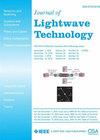New Prospects of Optical Wireless Communication Systems Exploiting VCSEL-Based Transmitters
IF 4.1
1区 工程技术
Q2 ENGINEERING, ELECTRICAL & ELECTRONIC
引用次数: 0
Abstract
In the last decades, Vertical Cavity Surface Emitting Lasers (VCSELs) emerged as a dominant technology for short-reach high-data rate networks thanks to several advantageous features. These include low power consumption, high modulation speeds, low costs, and compact size. More recently, these inherent characteristics of the VCSELs have also made them exceptionally suited for a variety of Optical Wireless Communication (OWC) applications, particularly for short-distance links, up to a few meters. This paper reviews a range of new and promising applications for VCSELs within emerging OWC domains: Data Centers (DCs), space, and harsh environment. We present and discuss different VCSEL-based OWC systems that were designed, implemented, and tested in these emerging scenarios. For the DCs scenario, we present a novel approach to establish OWC links able to reach data rates up to求助全文
约1分钟内获得全文
求助全文
来源期刊

Journal of Lightwave Technology
工程技术-工程:电子与电气
CiteScore
9.40
自引率
14.90%
发文量
936
审稿时长
3.9 months
期刊介绍:
The Journal of Lightwave Technology is comprised of original contributions, both regular papers and letters, covering work in all aspects of optical guided-wave science, technology, and engineering. Manuscripts are solicited which report original theoretical and/or experimental results which advance the technological base of guided-wave technology. Tutorial and review papers are by invitation only. Topics of interest include the following: fiber and cable technologies, active and passive guided-wave componentry (light sources, detectors, repeaters, switches, fiber sensors, etc.); integrated optics and optoelectronics; and systems, subsystems, new applications and unique field trials. System oriented manuscripts should be concerned with systems which perform a function not previously available, out-perform previously established systems, or represent enhancements in the state of the art in general.
 求助内容:
求助内容: 应助结果提醒方式:
应助结果提醒方式:


